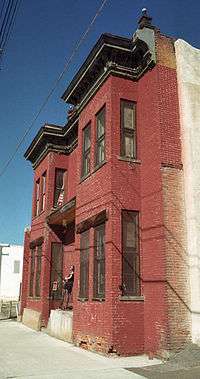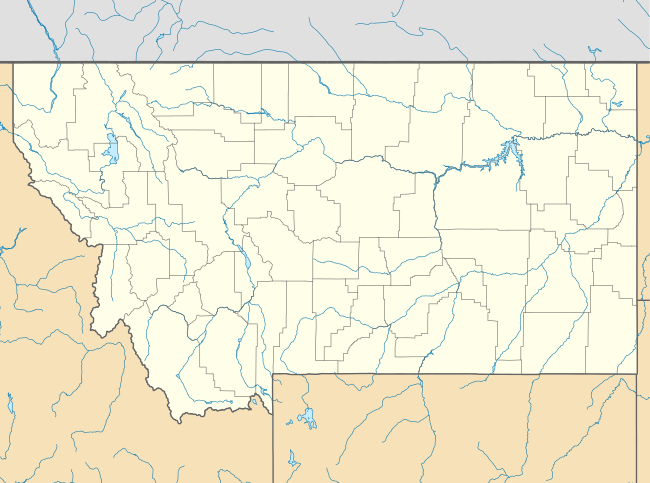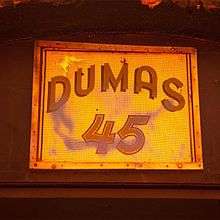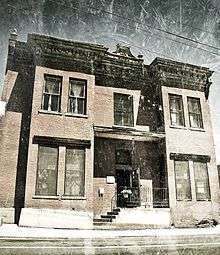Dumas Brothel
The Dumas Brothel was a bordello in Butte, Montana. The brothel was founded by French Canadian brothers Joseph and Arthur Nadeau in 1890 and named after the nominal owner, Delia Nadeau, née Dumas, who was Joseph's wife. It grew considerably through the years, with the miners employed by the city's copper mines often patronizing the establishment. After several changes of the "madams" and continuing pressure from authorities, the brothel closed in 1982, described as "a rare, intact commentary on social history". At the time of its closure, it was the longest operating brothel in the United States, having operated years after prostitution was made illegal. After closing, the brothel changed hands several times, eventually becoming a tourist attraction owned and managed by a series of Butte residents.
Dumas Brothel | |
 The Dumas Brothel | |
  | |
| Location | 45 East Mercury Street, Butte, Montana |
|---|---|
| Coordinates | 46.01143°N 112.534372°W |
| Built | 1890 |
| Architectural style | Victorian |
| Part of | Butte-Anaconda Historic District (ID66000438[1]) |
Background
In the 1870s, a group of women, called "ladies of the line", began selling sexual services on Park Street, in the north of the city of Butte, Montana.[2]:6 When the tents and shacks on the street were replaced with legitimate businesses some years later, the "Park Street girls", as they had come to be known, moved to the south of the city. By the mid-1880s, a variety of dance halls, gambling houses and saloons had appeared in the city. By 1888, Butte's East Galena Street was lined with brothels; in fact, nearly every building on the street housed prostitution. This area of Galena Street would come to be known as the "twilight zone".[2]:6 Paramount to these establishments was the Casino Theater, a mixture of a saloon, dance hall and brothel. In the late 19th century, several prominent Montanans owned brothels in Butte, including Lee Mantle, who would go on to be a United States Senator, and Anton M. Holter, a wealthy businessman from Helena, Montana.[2]:6–8
Two French Canadian brothers, Joseph and Arthur Nadeau, would eventually acquire the most property in Butte's prostitution areas, or "red light district". The brothers built a brothel in 1890 on 45 East Mercury Street and named it for Delia Nadeau, née Dumas, Joseph's wife.[3] By the turn of the century, there were three high-class sex houses in Butte: the Hotel Victoria, the Windsor Hotel and the Dumas Brothel, also called the Dumas Hotel.[2]:9–10
Description
The Dumas Brothel Museum is a two-story brick building at the north side of east Mercury street in the historic city of Butte, Montana. It also includes a basement level containing clandestine tunnels. There is a single story addition that was added to the rear of the main structure in 1912, and this leads directly onto the infamous brick- lined "Venus Alley", once the hub of Butte's red light district. The original structure features original vaulted skylights, and the upper level is surrounded by an interior balcony, which still provides a birds eye view for on-lookers to glimpse the suites (or "cribs") below. The basement afforded much more basic accommodations, and was built to connect the Dumas to Butte's business corridor via a tunnel system.
The Dumas Brothel was purchased by natives Michael Piche and Travis Eskelsen, who have been working to restore the building. They operate a museum and provide tours of the brothel beginning each spring and lasting until fall. Recently, they have added an antique shop and a souvenir gift shop, with plans to come that include opening a bed and breakfast at the site.[4]:228 After the death of Piche in 2018, Eskelsen put the building up for sale.[5]
History and operations
Scant details are known about the early history of the Dumas Brothel; however, two early boarders of the house listed their occupations as "gambler" and "saloon man" in census records.[3] By 1900 the brothel was occupied by Madam Grace McGinnis, her servant, a Chinese cook and four prostitutes.[2]:11 The cost of sex in the brothel at the turn of the 20th century was fifty cents, with the working girls receiving about 40 percent of that amount.[4]:228 Despite the size of the brothel, by 1902 Madame McGinnis had only five working girls and a musician under her employment. In 1903 the Dumas and businesses like it in Butte's red light district were unusually lucrative ventures.[3] These businesses were frequented by miners from the local Anaconda Copper Mining Company.[2]:6 That year, traffic grew to a point where the Dumas's operations had to be expanded, building "cribs" (tiny cubicles where the girls worked) in the basement of the house.[2]:4–6; 15[3] There were several ways potential clients could access the brothel. A back door of the Dumas opened into Pleasant Alley, near South Wyoming Street, which was the busiest section of Butte's red light area.[2]:11 The basement cribs could also be accessed by a staircase from the front sidewalk. Even though the Dumas operated 24 hours a day with several girls taking three shifts,[4]:228 by 1910 there were only two women reported to actually be living there. Instead the prostitutes lived in other parts of Pleasant Alley, and commuted to the brothel for their shifts.[3] In Butte, the activities of the city's prostitutes were generally restricted to Galena and Mercury Street. From the windows of their street-facing cribs, the girls would attract prospective clients while being in varying states of undress.[2]:12 The Butte Miner, a local newspaper, explained how the girls did this:
With an abandon that has no trace of modesty in it, these women lean out of their windows and address the vilest kind of language imaginable to people passing on the street, or else boldly make their appearance on the thoroughfare and visit from one crib to another.[2]:12
The Dumas's business and those like it were criticized by a number of people who sought to reform the red light district. Reverend William Biederwolf condemned Butte as "the lowest sinkhole of vice in the west," and that he saw "enough legitimate vice in Butte to damn the souls of every young man and young woman in it." Biederwolf held revival services for residents which attracted "rounders, gamblers and habitués of the red light district". However, the local business benefited and even depended on the support of the sex workers at the Dumas and other establishments like it. The prostitutes would buy their dresses at local clothiers, frequent the city's dry cleaners and would patronize Chinese herbalists, looking for birth control potions and venereal disease remedies. To ensure that their operations were unhampered, the girls at the Dumas would pay the city's police and governance five dollar "fines". Instead of the closing or relocating the red light district, the mayor and police of Butte ordered that the women wear longer skirts and high-necked blouses and that they "refrain from any indecent exposures." After these ordinances were put in place, the Butte Miner reported that "nothing was seen in the district except long dresses and long faces. What the women say about the matter is not fit for publication." By 1910 the people were petitioning Mayor Charles Nevin to shut down the district; with the district contributing two thousand dollars to the city's coffers every month, the efforts eventually died.[2]:13–16
In 1913 the brothel was expanded again. A one-story structure was added to the building, increasing the number of cribs by eight; four of the added cribs opened directly onto Pleasant Alley, by that time known as Venus Alley.[3][4]:228 When copper prices went up, the more than 14,000 miners in the city experienced a pay-rise of twenty-five cents and injected an additional $6,000 into Butte's economy.[2]:16 The Dumas also experienced an upswing in patronage. As a result of the added patronage, the brothel added five partitions and a staircase in 1916,[3] and the ground floor, once a grand parlor, was partitioned into cribs.[2]:16

World War I and the Prohibition impelled local lawmakers to initiate a crackdown on Butte's red light district; by 1917, the district was effectively closed. Signs saying "Men Under 21 Keep Out" were commonplace,[2]:17 and in the next census, prostitution had completely disappeared as a declared profession in Butte. The Dumas, however, remained in operation. In 1925 Anne Vallet began overseeing the Dumas for the Nadeau family, and in the 1930s, operations had passed to Madam Rose Davis. In 1940 Lillian Walden and her husband Dick began running the brothel,[3] raising the price of sex at the brothel to $2.[3][4]:228 Three years later, the US government ordered all brothels shut down to prevent the spread of venereal diseases among soldiers in World War II.[2]:17 In response, the Dumas began operating even more furtively, now under the guise of being a boardinghouse.[3] The "window-shopping" was abandoned completely and a heavy steel door was installed at the back of the Dumas with a small sliding window; customers would only gain entrance after the sliding window was opened and their identity was acknowledged.[3] Additionally, doorbells were added and a code system for dealing with troublesome guests was also employed.[3]
When Lillian Walden retired in 1950, the price for service at the brothel was $5.[3][4]:228 Afterwards, the Dumas's operations went to Elinore Knott. The Nadeaus also ceased being owners of the brothel around this time.[3] Knott's management of the Dumas was short. In 1955 she committed suicide after her lover died of a heart attack.[3] When the late 1960s came about, several local police officers were taking the initiative to close the three operating high-class sex houses: Hotel Victoria, Windsor Hotel and the Dumas.[2]:20 The Dumas did not remain closed for long however, with its next madam, Bonita Farren, operating it from 1955 until her death from cancer in 1969.[3] In 1970 the Dumas was listed in the National Register of Historic Places as a "Victorian Brothel" and an active house of prostitution.[4]:228 By the following year, Ruby Garret, a local resident of Butte for some thirty years, had purchased the Dumas. Garret would pay local police officers and officials $200 to $300 a month in return for their silence about the Dumas's activities.[2]:20 Under Garrett, the cost of a prostitute was $20.[4]:228 She would come upon financial difficulties however, being charged with tax evasion in 1981. The Dumas Brothel was closed the following year.[3]
After closure

In 1982 Ruby Garrett, the last madam of the Dumas, was convicted of federal tax evasion and served six months in prison.[6] The brothel was closed soon after, but not before a robbery took place there.[6] When it closed, it was the longest operating brothel in the United States, having operated for 92 years, long after prostitution was outlawed.[6]
Garret sold the Dumas to an antiques dealer named Rudy Giecek on the condition that it was preserved in its original state.[4]:228 Giecek turned the brothel into a museum and operated it as such for most of the 1990s. However, in 1998 Giecek encountered financial difficulties and attempted to sell the building. The International Sex Worker Foundation for Art, Culture and Education (ISWFACE) responded. The ISWFACE sought to reopen the Dumas as not only a museum but also a gallery and convention center.[4]:228–229 Ellen Baumler of the National Register of Historic Places wrote in support for the rescue of the Dumas that "[it] is not only significant as the last standing parlor house in this area of Butte, but also because of its length of operation as a rare, intact commentary on social history."[4]:229 Some were against the restoration of the Dumas, including former prostitutes in Butte, but the operation proceeded—at least until September 2000, when Giecek claimed the ISWFACE owed him $52,000 in wages for work performed at the Dumas. Giecek sued and was granted the wages he petitioned for and additional penalties. The business deal with ISWFACE was terminated however.[4]:229 In the years that followed, the Dumas was put up for auction twice as Giecek did not have the money to maintain the building.[4]:229
In late May 2005 Giecek was escorting a New York Times reporter through the Dumas for an interview when he discovered the place had been broken into.[7][8] Giecek, low on funds and worried about his health, had shut down the Dumas earlier that month after it had operated offering $5 tours.[4]:231[7] After the robbery, Giecek discovered "dismantled beds, stolen antique lamps and artwork and emptied glass cases full of brothel artifacts" as well as missing "rare sex toys".[7]
In June 2012 the Dumas was conveyed to new owners, locals Michael Piche and Travis Eskelson.[9][10] By this time however, the building was in great disrepair; among other things, there was water damage, a collapsed wall and no structurally sound roof.[9] The new owners planned to have summer tours for $8 in the following year,[9] but their ultimate goal was turning the Dumas into a bed and breakfast.[10] "It needs to be around. It needs to be here for the rest of the community and the people who want to visit it," said Piche.[10] In late 2013 the duo sought a loan from the local urban revitalization body in Butte.[11] The requested amount was $92,000 with an additional $8,750 grant.[11] As of December 2013, tours were still being offered at the Dumas on a limited basis.[11]
Rudy Giecek claims that the Dumas is haunted by the ghost of Elinore Knott.[8][12] Author Karen Stevens also recalled paranormal experiences related to the brothel. It is suggested that Knott's ghost is one of several at the Dumas.[12]
See also
References
- "National Register Information System". National Register of Historic Places. National Park Service. July 9, 2010. Retrieved January 11, 2015.
- Baumler, Ellen (1998). "Devil's Perch: Prostitution from Suite to Cellar in Butte, Montana" (PDF). Montana Historical Society. Retrieved 11 January 2015.
- MacKell, Jan (2009). Red Light Women of the Rocky Mountains. University of New Mexico Press. ISBN 082634612X.
- Gulliford, Andrew (2005). Preserving Western History. University of New Mexico Press. ISBN 0826333109.
- Emeigh, John (January 11, 2018). "Historic Dumas Brothel up for sale". KXLF-TV. Evening Post Industries. Retrieved April 22, 2018.
- Gevock, Nick. "Ruby Garrett, owner of Butte's Dumas Brothel, dies at 94". Missoulian.com. Retrieved 11 January 2015.
- "Rare Sex Toys Stolen From Brothel Museum". The Denver Channel. 25 May 2005. Retrieved 11 January 2015.
- Johnson, Kirk (30 May 2005). "Dark Days for a Reminder of the Wild, Wild West in Montana". The New York Times. Retrieved 11 January 2015.
- Trainor, Tim (8 July 2005). "Butte men buy historic Dumas Brothel". The Missoulian. Retrieved 11 January 2015.
- Harris, Katy (5 December 2012). "Historic Butte brothel to get new life". 8KPAX.com. Archived from the original on 17 January 2015. Retrieved 11 January 2015.
- Smith, Mike (25 December 2013). "Historic Dumas Brothel wants URA loan". The Montana Standard. Retrieved 11 January 2015.
- Birkenbuel, Renata (31 October 2014). "Boo! Writers tell of Butte's spooky haunts". Montana Standard. Retrieved 13 February 2015.